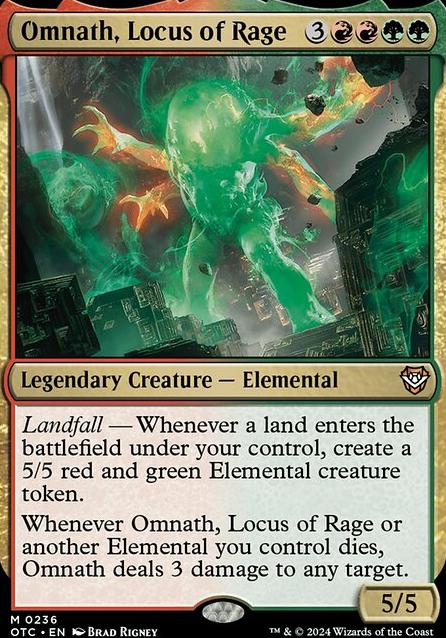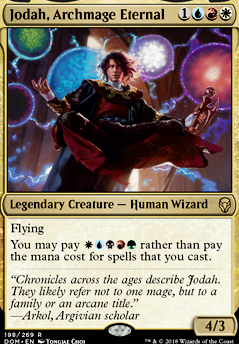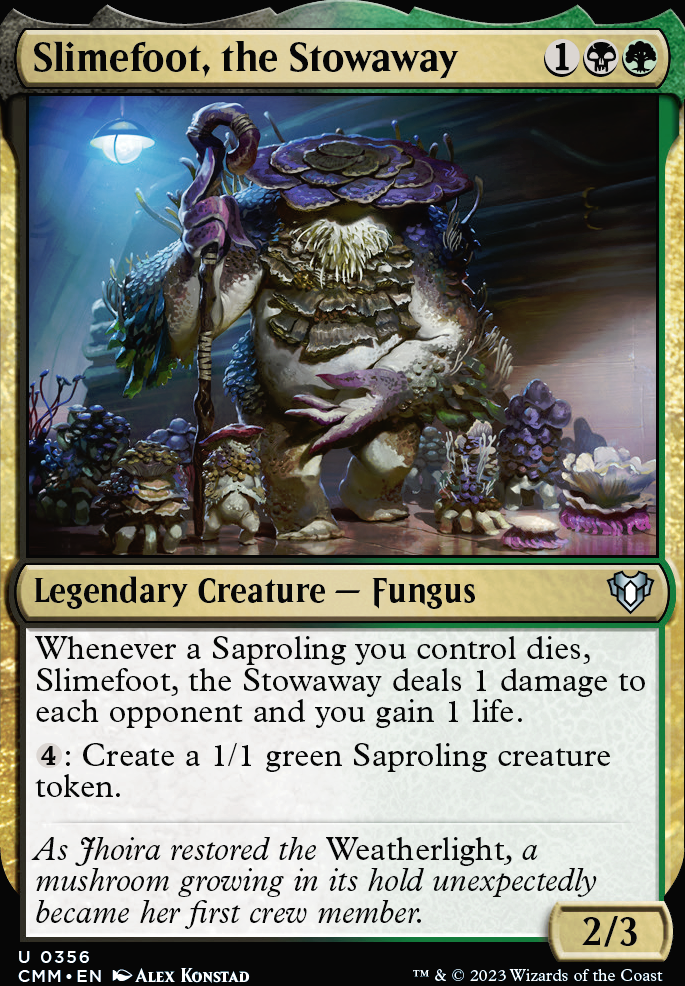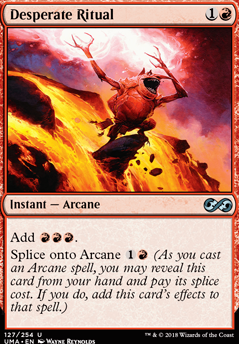I started playing EDH two and half years ago, and my first deck was an elemental tribal Omnath, Locus of Rage commander deck. This is not that deck.
Since my first rendition of Omnath, Locus of Rage, the deck has changed dramatically. Instead of playing derpy elementals and trying to landfall my way to victory, the deck plays out more like a Gruul combo deck. Omnath is still very important to the overall path to victory, however he is not entirely necessary to pull out a win. The deck consists of fast mana and ways to tutor up win conditions as early as turn 5. Generally, you should have enough mana to cast omnath by turn 4, and then proceed to either win through one of the combos or present lethal for the following turn by creating an absurd board state. This deck is fast, hits hard, and does not stop until either you, or everyone else, is out of the game.
Deck Overview
Strengths
This deck is inherently strong. The burst potential in a single turn can cripple the remaining players all but ensuring you a victory. Omnath, Locus of Rage is a strong center piece for this deck, however he is not needed. With the proper ramp, we have the ability to dish out huge amounts of damage through our other creatures. With all of the different creature tutors in green, it is hard to see how anyone else stands a chance. Red gives us access to burn, a tutor, and a counterspell. Red is a supplementary color in this deck. Without red, we would not have access to Purphoros, God of the Forge, Rolling Thunder, or Pyroblast. This deck has access to some of the most aggro oriented colors in magic, and the results are devastating.
Weaknesses
The main issue with this deck is it's reliance on land. This deck craves land, and wants to make land drops every turn. This can prove problematic when by turn five you have half the lands left in your deck. Eventually you stop drawing lands, and draw straight gas. This isn't a horrible problem, however it does affect how well Omnath, Locus of Rage performs in the late game. The deck needs to win early, or it will start to durdle. The heavy reliance on lands not only affects the late game, but our weakness to Armageddon type affects as well. If we lose all of our lands, we are screwed. We have two options: Crucible of Worlds and Splendid Reclamation. These cards will get you back in the game, however you still have to draw them. One main issue with the Gruul color pairing is the lack of tutors for anything besides a creature, which is why we run Gamble. This card can either win you, or lose you the game.
Removal, Tutors, Recursion, Card Draw, and Ramp
Removal
When deck building, the first thing I do is grab all of my basic removal spells in the appropriate colors, and put them in a pile. That removal will eventually be whittled down, slotted out for better pieces, or more modular ones. I start with removal because of its importance in games. When playing a game of commander, if you are not interacting with your opponent by turn two or three, you may have just lost the game. It is imperative that you disrupt your opponent as early as possible. Removal also helps to save you from your opponents game ending combo. Tapping out to ramp up, or make a big play that doesn't win you the game is the wrong way to go about it. Leaving mana open to remove their threats is what will keep the game going, and provide you with a safer path to victory. The removal I have included in this deck can be broken down by it's target's. For graveyard strategies, I run Tormod's Crypt. I feel this card gets the job done when I really need to slow someone down. As for permanent based removal, I run Beast Within, Song of the Dryads, Nature's Claim, and Vandalblast. When it comes to board wipes, I run only one. Rolling Earthquake is an all-star acting as both burn and a board wipe. With all the mana we can generate, sometimes one huge Rolling Earthquake can end the game.
Tutors
This deck runs multiple ways to get creatures into your hand or directly into play. The following are pretty self explanitory: Gamble, Tooth and Nail, and Natural Order. This suite of tutors allows me to pull up just about any creature I need for the right situation. Yes, cards like Natural Order are color restrictive, but that doesn't matter. There are plenty of green creatures I would love to tutor into play for basically free. As mentioned previously, Gamble is very versatile, however dangerous it can be. If you do happen to discard the card you wanted, we run quite a bit of recursion for just that situation.
Recursion
In order to get back our removal and creatures that have been sent to the graveyard, we run another small suite of cards. In green we have access to Eternal Witness, Seasons Past, Splendid Reclamation, and Crucible of Worlds. Most of the cards are pretty straightforward. Splendid Reclamation helps get back our lands after an Armageddon or Scapeshift. Crucible of Worlds fills a similar niche as Splendid Reclamation, however it also allows us to loop Strip Mine if we have access to multiple land drops per turn. Eternal Witness can bring back one of anything. Seasons Past is one of my newer inclusions to the deck, and it has performed exceedingly well in my meta. The ability to bring back up to seven or more cards has brought me back from death on many occasions.
Card Draw
Drawing cards is one of the most important aspects of magic. Take a look at a blue player someday and ask them what they find most important when playing magic. They almost always say drawing cards, and they are right. Top decking is not how you win games. You need to have a full grip of cards every turn. Having all of these cards in hand ensures that you will have an answer to another player a majority of the time. My deck consists of Sylvan Library, Harmonize, Faithless Looting, Tormenting Voice, Wheel of Fortune, and Greater Good. With these cards, I very rarely find myself without a hand in the late game. They also serve to refill my hand in the early game when I have dumped everything on the table in the first three to four turns. Sylvan Library essentially reads, lose eight life every turn draw three cards. Wheel of Fortune is a wheel, enough said. Greater Good is a sacrifice outlet that also gives you card advantage, and can be performed at instant speed in response to a Wrath of God or Cyclonic Rift. Finally, Harmonize is just a good value draw spell for its CMC.
Ramp
Ramp, the crux of this deck. Without it, how would we ever cast our general or do some of the more broken things our deck is designed to do early in the game. This list is long, so I will not be listing all of the spells, just some notable ones, and what category of ramp they would fall into.
First we have your generic ramp spell. This includes cards like Skyshroud Claim, Kodama's Reach, Sakura-Tribe Elder, and Rampant Growth. Spells like this will get you ahead of the other players in the early game. They tend to be less relevant late game, however if Omnath, Locus of Rage is still on the battlefield, they will net you 5/5 elementals.
Next we have artifact ramp. This section provides us with fast mana as early as turn one. We run Sol Ring, Mana Crypt, Mana Vault, Gruul Signet, and Grim Monolith. Artifact ramp gives you the ability to start your second turn but have the mana of someone on turn five. This explosiveness allows us to get our commander down as early as turn three or four depending on our opening hand.
Onto the dorks, mana dorks that is. We don't run very many of these, but the one's we do work out just fine. In this deck we have Birds of Paradise, Wall of Roots, and Shaman of Forgotten Ways among others. All these creatures do for us is provide a land on a body. Personally I would rather have a land, but having early blockers that also tap for mana can be very useful.
Finally, we have what I like to call static ramp. These cards give us the ability to make extra land drops. That's it, they just give us more land on each turn. Its simple, yet drastically speeds this deck up. Some notable cards are Burgeoning, Oracle of Mul Daya, and Azusa, Lost but Seeking.
Combo's:
- Omnath, Locus of Rage + Perilous Forays + (Lotus Cobra/Amulet of Vigor)
With Perilous Forays, you can pay to sacrifice a creature and search your library for a land with a basic land type and place it onto the battlefield tapped. This includes Taiga and Stomping grounds. If you have either a Lotus Cobra or Amulet of Vigor on the battlefield at the time, you will instead bring the land into play essentially untapped. This untapped land can then be tapped for to sacrifice the newly formed Elemental token created by the landfall trigger to search up an additional land. Each time you sacrifice an elemental to repeat this process, Omnath, Locus of Rage will deal three damage to a target creature or player. The deck runs a large amount of basics, so this can easily take out at least one player at the table.
- Prismatic Omen + Scapeshift + Valakut, the Molten Pinnacle
Sometimes a Modern combo can become relevant in EDH. I believe the versatility of Scapeshift warrants the inclusion of Prismatic Omen. Scapeshift on it's own can close out games for us, by making more elementals than we could imagine, either through Omnath, Locus of Rage, Titania, Protector of Argoth, or both. The way the Scapeshift combo works, Prismatic Omen must be on the field for this deck to utilize it to its full potential. We do not run enough basic mountains in this deck to fully capitalize on it. Scapeshift relies on Valakut, the Molten Pinnacle to see the other mountains enter. Prismatic Omen turns all of our forests into mountains, thus causing Valakut to trigger when they all enter play. If we do happen to have Prismatic Omen as we draw into Scapeshift, we can sometimes either remove a player from the game or wipe their board through the damage it creates. If we have only ten lands on the battlefield, that is thirty damage when we scapeshift away all ten lands.
Notable Cards and Interactions:
Purphoros, God of the Forge- This card has the unique ability to help us win via a game of attrition or through an explosive turn filled with creatures entering the battlefield. Purphoros works very well with both Omnath, Locus of Rage and Avenger of Zendikar to quickly close out most games.
Tooth and Nail- One of the best green cards ever printed. Tooth and Nail can search up any two creatures from your deck and place them directly into play. Some of the best pairs to grab are:
Purphoros, God of the Forge + Avenger of Zendikar
Craterhoof Behemoth + Avenger of Zendikar
Urabrask the Hidden + Shaman of Forgotten Ways
Craterhoof Behemoth + Urabrask the Hidden
Warstorm Surge- Think of this card as a second Purphoros, God of the Forge, but without the ability to tutor it up with Tooth and Nail. This card can get really out of hand, if a Doubling Season is out on your side of the board, when Omnath, Locus of Rage's landfall ability triggers.
Conclusion
As stated, the deck is a blast to play, and packs enough interaction that you never feel like the game is completely out of your hands. Through the many games I have completed with this deck, I can wholeheartedly say it is one of the most resilient EDH decks I have ever created, and will continue to be one of my favorite decks to pilot on a regular basis. If you have any suggestions Let me know, and if you liked the deck, please feel free to give it a +1. Thank you, and I hope this description has been of some help to those trying to build their own Omnath, Locus of Rage EDH deck.
























